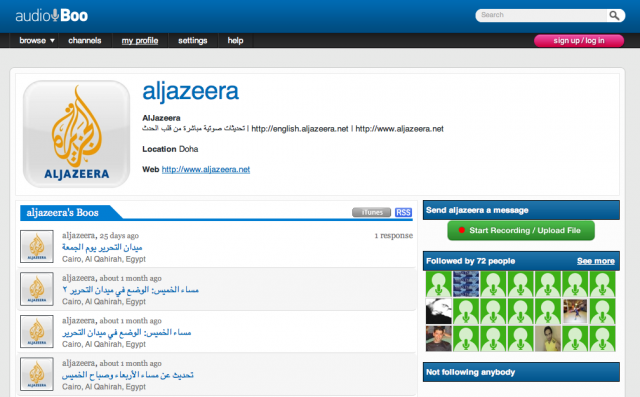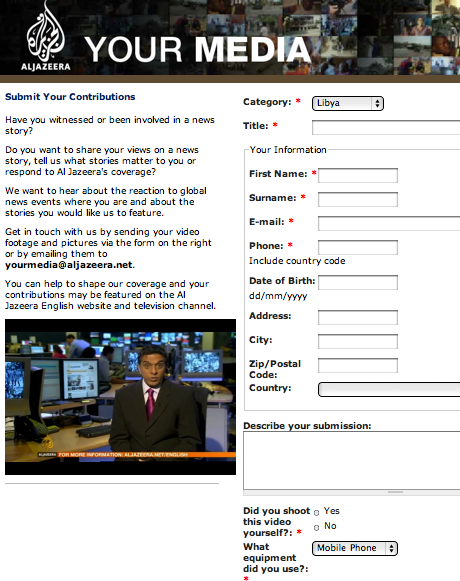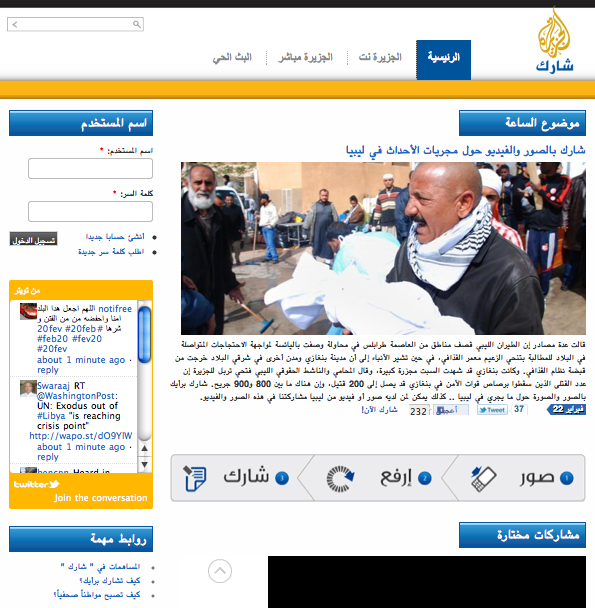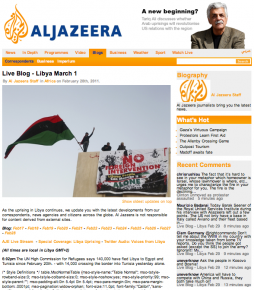Recent events in Tunisia, Egypt, and Libya have been on the minds -- and on the screens -- of people around the world.
News organizations are covering the events in innovative ways, and people have noticed. More generally, the role of social media itself in protests and revolutions is also being debated. But, as Charlie Beckett writes on his blog, let’s “put aside the silly debate about whether Twitter 'caused' revolution and look instead at how it helped tell the story.” Twitter is just one platform being used to help tell the story, as we see from our conversation with Al Jazeera, one of the most innovative newsrooms in the mix.
MobileActive.org spoke with Riyaad Minty, head of social media for Al Jazeera Network, and Safdar Mustafa, who heads up the mobile media unit, to learn more. While many of the examples here are unique to reporting in fast-moving and volatile events, the general lessons are applicable to individuals, media organizations, and traditional newsrooms.
Innovative ways to tell the story
Al Jazeera takes a multi-platform approach to coverage and incorporates live blogs, Flickr pages and audio reports, Twitter, Facebook, and Youtube. (During the Egyptian protests, the online live stream was one of the most popular items on the website and web traffic grew by 2500% during this time.) For the audio reports, Al Jazeera uses Audioboo, a mobile and web platform, to record, listen and share audio content. In Egypt, for example, Al Jazeera used Skype to call individuals, recorded the conversation using Call Recorder software, and posted it online via Audioboo. 
The Al Jazeera web team also uses Scribble Live, a content delivery platform for posting and editing real-time, user-generated content. This way, people could call in audio reports, even if they were on the move. “This proved very handy in Egypt when people were getting attacked. They were able to just dial a number, record the report, and this would be posted online,” Riyaad Minty said. The report would be reposted on Audioboo and embedded on the Al Jazeera website or shared on TV.
Lesson: To innovate, be innovative!
Al Jazeera is often seen as a leader in media innovation. So how did it get there? “There is no checklist,” Minty said. But part of the answer lies in a curious, experimental approach. “One of the things about innovation is being flexible and agile,” Minty said. His team is constantly looking for the newest tools available. Knowing how to stay connected, regardless of conditions on the ground, is critical.
The team at Al Jazeera knows how to work in any number of conditions, in what Minty calls different “phases” of connectivity within a region. At one end, there is full connectivity to the Internet and mobile networks; limited connectivity, and no connectivity, Minty said. “We outline these three and try to find the best tools for each scenario.”
In volatile environments like Egypt during mass protests, in Tunisia, and now in Libya, equipment is key for correspondents and citizen reporters, especially discrete equipment like mobiles and smaller satellite equipment, Safdar Mustafa notes. “If there is a communication blackout, you need to know how you can connect a satellite to a mobile phone, because these are often the only things you may have with you.” In such an environment, a news organization may need to readjust its approach quickly.
“That’s the basis I’ve been working under -- what is the minimum amount of equipment here, and what can we do?” Mustafa said.
Lesson: Test, test, test! (But be prepared to hack, too)
Preparation is key. Based on previous experiences, Minty said, he realized that the first thing that often gets disrupted during volatile events is the Internet, and with it, access to online media. When this happens, a good back-up plan is necessary to ensure that events are covered.
One of the first steps is to identify key people on the ground before (and often, as) things are happening. “We were able to get phone numbers and establish a network of bloggers on the ground that we could connect with directly,” Minty said. “So when and if the Internet is down, Al Jazeera can use these phone numbers and contacts to call and get firsthand reports.”
While it is difficult to predict what news gathering tools or platforms will be the most popular on a given day or at a particular scene, it is possible to be prepared.
Al Jazeera tests various tools at its newsroom headquarters in Doha, Qatar. So, once they are out in the field and “things start happening,” the team and the correspondents have a good understanding of how the tools and platforms can be used.
“But things change quickly, so sometimes it’s just hacking things together that makes the most sense,” Minty said. For example, calling people in Egypt to record audio reports via Skype and on Audioboo wasn’t something the team tested in Doha. Rather, faced with the Internet blackout in Egypt, Al Jazeera suddenly found it needed to call people for updates. The team put the Call Recorder-Skype-Audioboo process together on the fly.
The environment in which you are reporting is key. Mustafa said that in new platform or tool trials, adoption is slow. “But when a war breaks out or there is mass protest, people really want a way to get information to us. Then, suddenly, the project takes off.” Put lightly, there are often “a lot of half-baked projects in which you think, let’s see if this flies,” Mustafa said. “Some of them don’t, and some of them really take off.”
Lesson: Citizen media is really, really important
Or “incredibly important,” in Minty's words. In fact, Minty does not even consider citizen media through social channels new media; it is simply media at this point. Al Jazeera has been a key leader in the use of citizen media, before events in Egypt and North Africa, and they have learned some things along the way. The first is quite obvious: citizen reports can augment traditional news gathering when professional correspondents can’t get to the story or the sources.
Al Jazeera has been a key leader in the use of citizen media, before events in Egypt and North Africa, and they have learned some things along the way. The first is quite obvious: citizen reports can augment traditional news gathering when professional correspondents can’t get to the story or the sources.
In Tunisia, for example, Al Jazeera was banned and had no correspondents on the ground. During the early days of the revolt, the majority of content was coming through social networks and social media, Minty said. The newsroom would repost and rebroadcast much of this citizen content.
It was different in Egypt, where Al Jazeera had camera crews on the ground. It was able to track, in real time, what was happening with the protests. “I think what a lot of people found useful from us was the live shots we had of Tahrir Square,” Minty said. “But where we wouldn’t go live we had a lot of citizen media reports coming out.”
Lesson: Push as well as pull
Another key lesson from Al Jazeera is using social media to not only glean and augment traditional media content, but to push content to the public. The team learned from covering the Gaza War that “when we weren’t getting a lot of citizen media, we could take our images and video and use social media or digital media to redistribute it online so the world could see it,” Minty said. “It’s taking our content and pushing it out.” 
On the English channel, Al Jazeera has a citizen media platform called Your Media; in Arabic, it’s called Sharek. The citizen media sites ask people who have witnessed or been involved in a news story to submit contributions. Citizens can send pictures and video via email or using a form at the Your Media/Sharek sites.
Lesson: Always verify citizen reports
Minty said “there is always verification. There is a lot of noise that happens out there.”
So, how to do this? “In a lot of countries, we try to identify people beforehand. We get phone numbers and location verification of people we could trust,” Minty said. “We started building a database of people we could follow.” One way to do this is to search for people in a region who are already posting online content. A key lesson here is timing: these trusted relationships need to be established early on, before any potential Internet or communication blackout within a region.
For content that is submitted via email or on Your Media or Sharek, Al Jazeera tries to get in touch with citizen journalist. “We try to get a phone number, an e-mail address, to get direct contact with them to have a discussion to see where the information came from and when it was recorded,” Minty said.
Verification of time is important with citizen media reports. “What we see a lot of the time is content that might have been recorded 3 or 4 days ago but it gets uploaded today,” Minty said. “So it’s not relevant to today’s breaking news but it can add more information or context.” Content of this nature is put in context, and includes information on “where we received it, how we received it, and the date we believe it was taken.”
Lesson: Mobiles are important for both recording and receiving content
At Al Jazeera, Mustafa looks at mobiles from two perspectives. The first is equipping correspondents with the right mobile tools, especially when it becomes difficult to get into or report from certain regions or countries. “We’re having to resort to mobiles, and seeing how they can be used when there is a communication blackout,” Mustafa said.
The second is creating avenues to receive mobile content from citizens. “We’re getting a lot of content which is being recorded via mobile and being sent in to Al Jazeera through various channels,” Mustafa said. Al Jazeera is currently building a number of applications which will allow the user to send content direct from Android or Blackberry phones. “But even without that, we’re getting so much content from mobile from the general public,” Mustafa said.
Giving citizens options to submit content is ideal. "It's up to the people on the ground," Mustafa said. "So, if you have a basic mobile, you're probably going to go home, transfer content to your laptop and upload it to the website. Or, if you can send e-mail from your mobile, you're probably going to send it direct to our e-mail address."
Lesson: Share the knowledge in the newsroom and beyond
One reason for Al Jazeera’s success in innovative coverage is support from the top down. “We have a lot of support from senior management who believe in the power of new media and believe that this is the future of media,” Minty said. “When I speak with a lot of other news organizations, a lot of them are still asking the questions that we were asking 4 or 5 years ago.”
A shift toward innovation also comes from within the newsroom, too. “There is a fundamental shift that needs to happen within a newsroom to make it successful,” Minty said. Those that understand new media strategies and tools share with others. The new media department at Al Jazeera is 12 people strong, and growing. But the important thing is the transference of skills to the newsroom.
“It’s not about having a single dedicated social media team to handle everything,” Minty said. “We come up with the strategy and experiment with the tools to see how they can be handed over to the newsroom to own the project and try it themselves.”
While the Al Jazeera lab team does not offer specific trainings in new media development, Minty has spoken at meetings and seminars. “A lot of people involved in this are connected, everyone is open to bounce ideas and identify ways to move forward,” Minty said. “From our side, we are very open with our strategy and what has or hasn’t worked.”


Post new comment